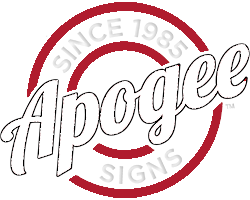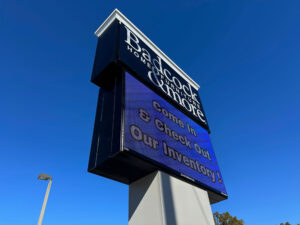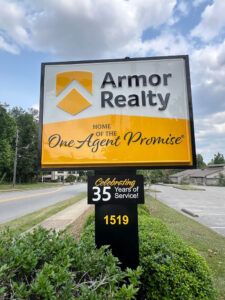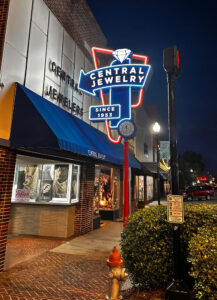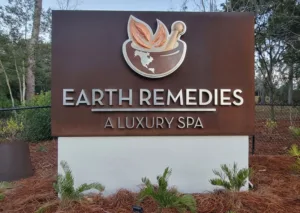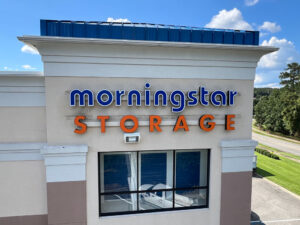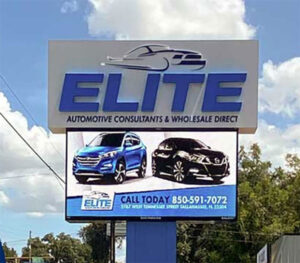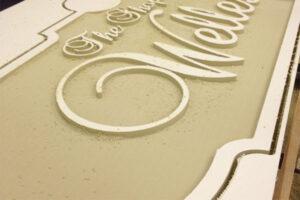
Routed Signage: Durable, Eye-Catching Signs for Your Business
Routed signage offers a perfect blend of durability and visual appeal for showcasing your business or organization’s identity. These signs are crafted by using a specialized routing machine to meticulously cut letters and logos from solid materials like wood, plastic, or metal. This precise technique results in a clean, crisp finish that can be customized with various paint colors and finishes to perfectly match your brand image.
Routed signs are a popular choice for exterior applications such as storefront signage and directional displays. Their resilience makes them ideal for withstanding outdoor elements. But routed signage isn’t limited to outdoor use. They can also make a powerful statement indoors, adding a touch of sophistication to lobbies, conference rooms, and other interior spaces.
The combination of durability and versatility makes routed signs a smart investment for any business or organization seeking to create a lasting impression.
Below, we answer some of the most frequently asked questions about routed signage:
How is routed signage different from other types of signage?
Routed signage is different from other types of signage because it creates a raised or recessed effect on the surface of the sign, giving it a unique and distinctive appearance.
What are the benefits of using routed signage?
The benefits of using routed signage include durability, versatility, and customization options. Routed signage is also weather-resistant and can be used indoors or outdoors.
What materials are commonly used for routed signage?
Common materials used for routed signage include wood, PVC, HDU (high-density urethane), and metal.
What is the process for creating routed signage?
The process for creating routed signage involves creating a design, transferring the design to the material, and then using a router or other cutting tool to cut out the design. The sign is then sanded, painted or finished, and assembled if necessary.
How much does routed signage cost?
The cost of routed signage varies depending on the size, material, design complexity, and other factors. Prices can range from a few hundred dollars to several thousand dollars for larger or more intricate signs.
What are some examples of businesses or organizations that commonly use routed signage?
Businesses and organizations that commonly use routed signage include restaurants, retail stores, offices, schools, churches, and other organizations that want to create a unique and eye-catching sign.
How do I choose the right routed signage for my business or organization?
When choosing routed signage, consider your budget, the desired size and style of the sign, the materials and design options available, and the environment where the sign will be displayed. You may also want to consult with a professional sign maker or designer to help you create a sign that meets your needs and reflects your brand identity.
What is the difference between a CNC router and a traditional router?
A CNC router is computer-controlled and can make precise cuts and shapes, while a traditional router is operated by hand and relies on the user’s skill and experience.
What types of materials can be used for routed signage?
Routed signage can be made from a wide variety of materials, including wood, PVC, HDU foam, acrylic, and aluminum.
How long does it take to produce a routed sign?
The production time for a routed sign can vary depending on the size, complexity, and quantity of signs ordered. However, most signs can be produced within a week to 10 days.
Can routed signage be illuminated?
Yes, routed signage can be illuminated using a variety of methods, including backlighting, edge lighting, and front lighting.
What is the lifespan of a routed sign?
The lifespan of a routed sign can vary depending on the materials used and the environment in which it is installed. However, most routed signs can last for several years with proper maintenance.
Can routed signage be used for outdoor applications?
Yes, routed signage can be used for outdoor applications, but it is important to choose materials that are durable and weather-resistant.
Ready to Invest in Routed Signage?
We hope this FAQ section has shed some light on the many benefits and applications of routed signage. If you have any further questions or would like to discuss a custom routed sign for your business, don’t hesitate to contact us. Our team is happy to help you bring your vision to life and ensure you get a routed sign that perfectly represents your brand and stands the test of time. Let us help you create a lasting impression with high-quality, routed signage!
